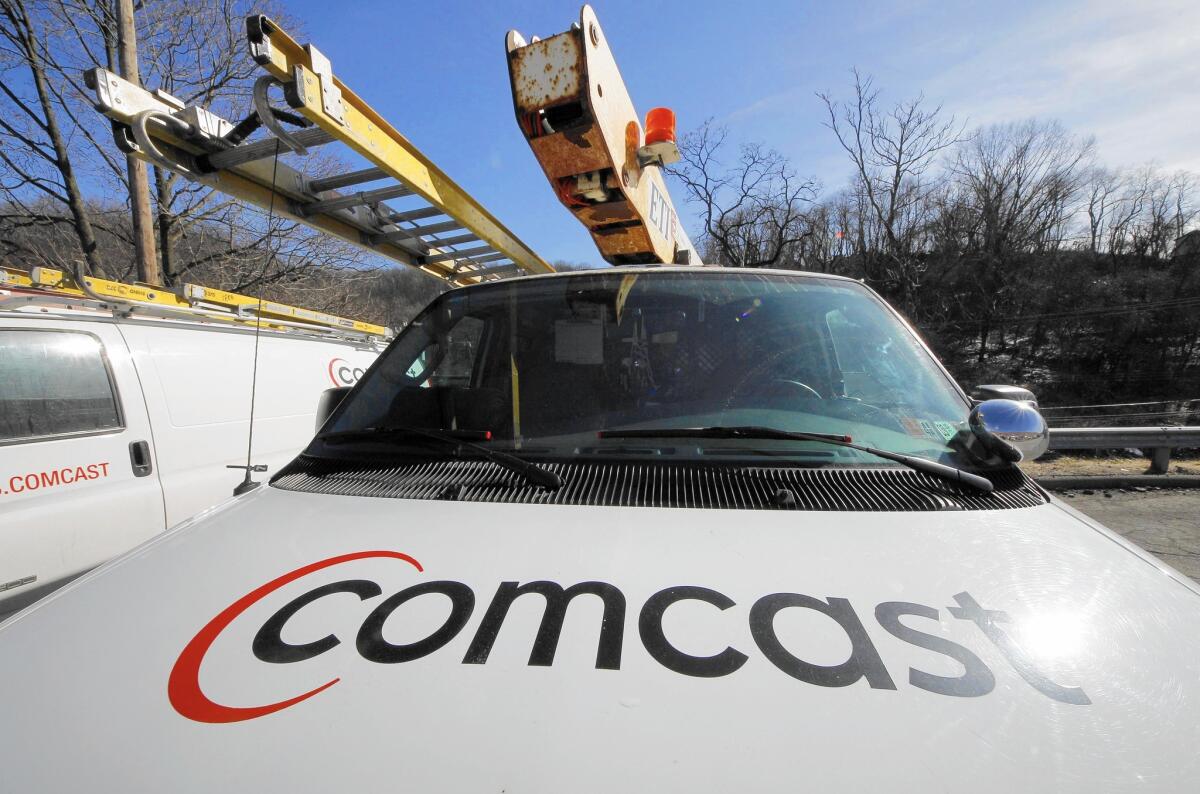Comcast’s big gain in Internet service users fuels 50% profit increase

Comcast Corp. added 315,000 high-speed Internet service customers during the third quarter, surpassing analysts’ estimates for subscriber growth and boosting the company’s earnings.
The gains more than offset Comcast’s loss of 81,000 cable television customers during the July-through-September period. Still, that marked the Philadelphia cable giant’s best third-quarter retention of TV subscribers in seven years.
Wall Street closely monitors subscriber trends to gauge the overall health of the company — and the entire pay-TV industry.
Analysts have been watching for evidence that consumers have been cutting the cable cord — or just switching to another provider. Comcast attributed its improved retention to the wider rollout of its upgraded bundled packages of Internet and TV service, which have been deployed in 5 million homes.
Comcast already is the nation’s largest cable operator. It is awaiting government approval of its $45-billion acquisition of Time Warner Cable Inc., which would give Comcast nearly 30 million customers, including millions in the nation’s largest markets: Los Angeles, New York and Chicago.
Comcast Chief Executive Brian Roberts said Thursday the government’s review was proceeding. He said he expects the Time Warner Cable transaction to be completed early next year.
For the quarter that ended Sept. 30, Comcast’s net income increased 50% to $2.59 billion, or 99 cents a share, from $1.73 billion, or 65 cents, a year earlier.
Adjusted earnings came in at 73 cents a share, which beat analysts’ estimates of 71 cents a share.
Revenue was up 4% to $16.79 billion.
“Each quarter it seems that they are consistently delivering improvements in areas where they said they would try to improve,” said Dave Heger, senior equity analyst with Edward Jones & Co. “They are executing on their strategy.”
Comcast’s core business remains its cable TV, high-speed Internet and telephone service packages. Two-thirds of Comcast’s customers take two or more of its services.
Revenue in that division rose 5.2% to $11 billion. Operating cash flow was up 5% to $4.46 billion.
Comcast’s NBCUniversal media company also posted improved third-quarter results, as a result of ratings gains at the NBC broadcast network and greater attendance at Universal Studios theme parks.
NBCUniversal’s overall revenue increased 1.2% to $5.92 billion. Its operating cash flow jumped 13.3% to $1.42 billion.
The NBC broadcast division’s revenue increased nearly 8% to $1.77 billion. Its flagship NBC network finished the most recent TV season in first place in the coveted advertising demographic of viewers ages 18 to 49 — NBC’s best result in 10 years.
“They have really turned around NBC, and that’s where the upside is in terms of boosting profitability,” Heger said.
Theme parks delivered 19% revenue growth, to $786 million. The company is generating record ticket sales this year, in large part because of the popularity of the Wizarding World of Harry Potter attraction in Orlando, Fla.
“The investments we have made in the businesses are paying off,” Roberts said.
Los Angeles film studio Universal Pictures witnessed a 15% drop in revenue to $1.2 billion because of lower box office results. The studio released fewer films and had tough comparisons because last year it was riding high with the blockbuster animated hit “Despicable Me 2.”
Growth at NBC’s cable TV networks —including USA, Bravo and CNBC — has stalled. Revenue was up just 1% to $2.26 billion. Drooping ratings at the general entertainment networks prompted a 5% reduction in ad revenue, which was offset by an increase in programming fees.
NBCUniversal Chief Executive Steve Burke warned that the cable channel business is becoming more challenged.
“These are going to be tougher businesses than they have been,” Burke said. The reason: There is more competition, and viewer habits are changing.
“People have more options to watch quality, professionally produced video than ever before, and they are using those options — whether it is DVR, Netflix or Hulu,” Burke said. “That competition, combined with new technology, is making it harder and harder to deliver the ratings that we’ve been used to.”
Follow me on Twitter: @MegJamesLAT
More to Read
From the Oscars to the Emmys.
Get the Envelope newsletter for exclusive awards season coverage, behind-the-scenes stories from the Envelope podcast and columnist Glenn Whipp’s must-read analysis.
You may occasionally receive promotional content from the Los Angeles Times.







